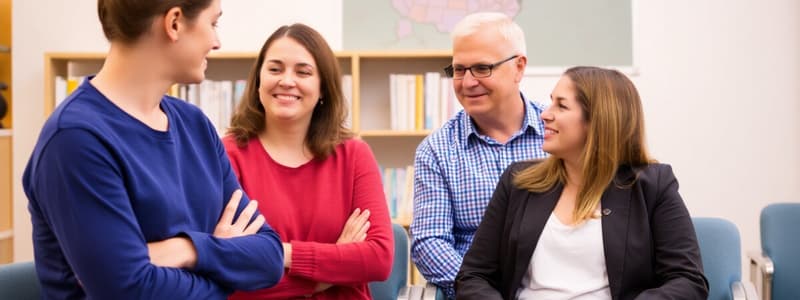Podcast
Questions and Answers
What is typically a characteristic of role models?
What is typically a characteristic of role models?
- They possess qualities that attract others. (correct)
- They have no influence on younger people.
- Their success is often unrecognized.
- They are usually well-known public figures.
What can peer pressure lead young people to do?
What can peer pressure lead young people to do?
- Completely avoid risky activities.
- Engage in constructive behaviors.
- Only follow the expectations of their family.
- Experiment with risky behaviors. (correct)
What distinguishes active listening from passive listening?
What distinguishes active listening from passive listening?
- Active listening requires response and reflection. (correct)
- Passive listening involves interrupting the speaker.
- Active listening is the same as ignoring the speaker.
- Passive listening requires taking notes.
Which statement about emotions is true?
Which statement about emotions is true?
What is the role of empathizing in coping with emotions?
What is the role of empathizing in coping with emotions?
How can peer pressure manifest in the digital age?
How can peer pressure manifest in the digital age?
Which of the following is an effect of different emotional situations?
Which of the following is an effect of different emotional situations?
What is a common misunderstanding about role models?
What is a common misunderstanding about role models?
Flashcards
Role Models
Role Models
People whose behavior or success others copy, especially younger people.
Peer Pressure
Peer Pressure
Influence from friends or similar-aged people to change attitudes, values, or behavior.
Active Listening
Active Listening
Paying close attention, understanding, responding, and remembering what a speaker says.
Passive Listening
Passive Listening
Signup and view all the flashcards
Coping with Emotions
Coping with Emotions
Signup and view all the flashcards
Positive Feelings
Positive Feelings
Signup and view all the flashcards
Negative Feelings
Negative Feelings
Signup and view all the flashcards
Empathizing
Empathizing
Signup and view all the flashcards
Study Notes
My Role Model
- Role models are people whose behavior or success is copied, especially by younger people.
- Role models often have desirable qualities and behaviors that influence others.
- Role models can be known or unknown individuals.
- Role models can be unexpected, such as a teacher or a sibling.
Peer Pressure
- Peer pressure is influence from friends or people of similar ages.
- It can encourage risky behaviors, like drug use, fighting, or sexual activity.
- Peer pressure can cause harmful behaviors like carrying weapons or destroying property.
- Peer pressure can occur online via social media.
Listening
- Active listening involves paying close attention to a speaker.
- Understanding the speaker's message, responding appropriately, and remembering the information are key aspects of active listening.
- Passive listening involves minimal response to the speaker.
- In passive listening, a person is not really paying attention.
Coping with Emotions
- Different situations evoke various emotions.
- Positive and negative emotions are normal responses to situations.
- Emotions affect relationships with others.
- Understanding, managing and coping with emotions is important.
- Empathizing with others is a skill that involves understanding another person's feelings.
Studying That Suits You
Use AI to generate personalized quizzes and flashcards to suit your learning preferences.




